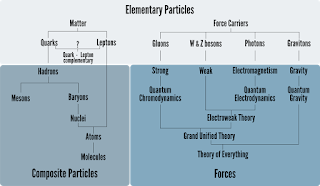A word on visuals: Using text in slides part II
In part I I talked about the shape of the text in slides. In part II I want to address the content. There are two basic questions. One is, when is the use of words better than the use of pictures? And the other, how to effectively use words in pictures?
Let me kick off with the diagram below that I found in Wikipedia and remixed.
On question that putting the information shown here into a written form would take more time to process. This is the point that the director of the Data Visualization at the University of New Hampshire, Colin Ware, makes. According to Mr. Ware, hierarchical relationships are most effective presented in a structured diagram (Graphics 1, Text 0). Now take a look at the diagram below. It is called a flowchart, and it is used to graphical display an algorithm. In this case computing the factorial of n, n!. In case you wonder n! = 1 x 2 x ... x n.
The pseudocode of this flowchart would be something like this:
read n
f = 1, m = 1
mark: f = f*m
if(m == n)
print f
else
jump to mark
end
In this case text performances better than graphics.
Here are some guidelines, from Mr. Ware's book Information Visualization, when text works better than images and vice versa. In general images are better for spatial structures, location, and detail, whereas words are better for procedural information, local conditions, and abstract verbal concepts.
- Images are best for showing structural relationships, such as links between entities and group of entities.
- Tasks involving localization information are better convey using images.
- Words work better for abstract images. That is, visual information ought to be meaningful and capable of incorporation into into a cognitive framework. If visual information is new and represented abstractly and presented out of context, image memory cannot rely into it.
- Images are best for providing detail and appearance . The amount of information shown in a picture should be related to the amount of time available to study it.
- Text is better than graphics for conveying abstract concepts, such as freedom or efficiency.
- Procedural information is best provided using text or spoken language.
- Information that specifies conditions under which something should or shouldn't be done is better provided using text.




Comments
Post a Comment